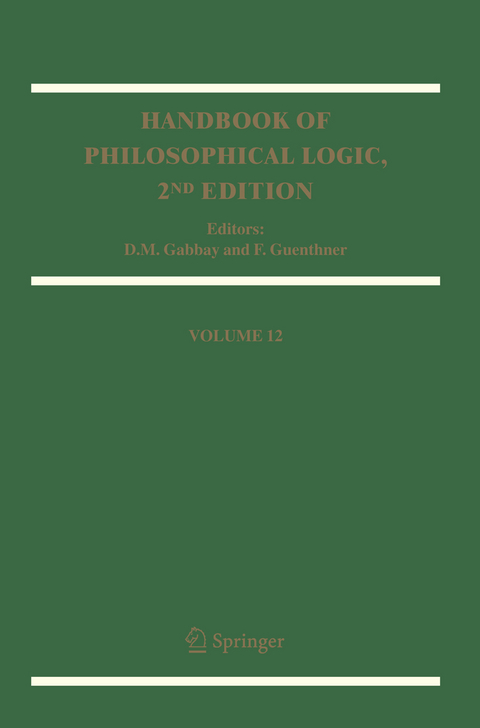
Handbook of Philosophical Logic
Volume 12
Seiten
2005
|
2nd ed. 2005
Springer-Verlag New York Inc.
978-1-4020-3091-8 (ISBN)
Springer-Verlag New York Inc.
978-1-4020-3091-8 (ISBN)
A useful reference work to both students and researchers in formal philosophy, language and logic. This second edition is intended to comprise some 18 volumes and provides in-depth coverage of major topics in philosophical logic and its applications in many cutting-edge fields relating to computer science, language, argumentation, and others.
such questions for centuries (unrestricted by the capabilities of any ha- ware). Theprinciplesgoverningtheinteractionofseveralprocesses, forexample, are abstract an similar to principles governing the cooperation of two large organisation. A detailed rule based e?ective but rigid bureaucracy is very much similar to a complex computer program handling and manipulating data. My guess is that the principles underlying one are very much the same as those underlying the other. Ibelievethedayisnotfarawayinthefuturewhenthecomputerscientist will wake up one morning with the realisation that he is actually a kind of formal philosopher! The projected number of volumes for this Handbook is about 18. The subjecthasevolvedanditsareashavebecomeinterrelatedtosuchanextent that it no longer makes sense to dedicate volumes to topics. However, the volumes do follow some natural groupings of chapters. I would like to thank our authors and readers for their contributions and their commitment in making this Handbook a success. Thanksalso to our publication administrator Mrs J.
Spurr for her usual dedication and excellence and to Kluwer Academic Publishers (now Springer) for their continuing support for the Handbook. Dov Gabbay King's College London x PREFACE TO THE SECOND EDITION Logic IT Natural Program Arti?cialin- Logic p- language control spec- telligence gramming processing i?cation, veri?cation, concurrency Temporal Expressive Expressive Planning. Extension of logic power of tense power for re- Time depen- Horn clause operators. currentevents. dent data. with time Temporal Speci?cation Eventcalculus. capability. indices. Sepa- of tempo- Persistence Eventcalculus. ration of past ral control. through time- Temporal logic from future Decision prob- the Frame programming.
such questions for centuries (unrestricted by the capabilities of any ha- ware). Theprinciplesgoverningtheinteractionofseveralprocesses, forexample, are abstract an similar to principles governing the cooperation of two large organisation. A detailed rule based e?ective but rigid bureaucracy is very much similar to a complex computer program handling and manipulating data. My guess is that the principles underlying one are very much the same as those underlying the other. Ibelievethedayisnotfarawayinthefuturewhenthecomputerscientist will wake up one morning with the realisation that he is actually a kind of formal philosopher! The projected number of volumes for this Handbook is about 18. The subjecthasevolvedanditsareashavebecomeinterrelatedtosuchanextent that it no longer makes sense to dedicate volumes to topics. However, the volumes do follow some natural groupings of chapters. I would like to thank our authors and readers for their contributions and their commitment in making this Handbook a success. Thanksalso to our publication administrator Mrs J.
Spurr for her usual dedication and excellence and to Kluwer Academic Publishers (now Springer) for their continuing support for the Handbook. Dov Gabbay King's College London x PREFACE TO THE SECOND EDITION Logic IT Natural Program Arti?cialin- Logic p- language control spec- telligence gramming processing i?cation, veri?cation, concurrency Temporal Expressive Expressive Planning. Extension of logic power of tense power for re- Time depen- Horn clause operators. currentevents. dent data. with time Temporal Speci?cation Eventcalculus. capability. indices. Sepa- of tempo- Persistence Eventcalculus. ration of past ral control. through time- Temporal logic from future Decision prob- the Frame programming.
Knowledge Representation with Logic Programs.- The Resolution Principle.- How to Go Nonmonotonic.
| Erscheint lt. Verlag | 25.8.2005 |
|---|---|
| Reihe/Serie | Handbook of Philosophical Logic ; 12 |
| Zusatzinfo | XIII, 372 p. |
| Verlagsort | New York, NY |
| Sprache | englisch |
| Themenwelt | Geisteswissenschaften ► Philosophie ► Allgemeines / Lexika |
| Geisteswissenschaften ► Philosophie ► Logik | |
| ISBN-10 | 1-4020-3091-6 / 1402030916 |
| ISBN-13 | 978-1-4020-3091-8 / 9781402030918 |
| Zustand | Neuware |
| Haben Sie eine Frage zum Produkt? |
Mehr entdecken
aus dem Bereich
aus dem Bereich
die letzten Jahre der Philosophie und der Beginn einer neuen …
Buch | Hardcover (2024)
Klett-Cotta (Verlag)
28,00 €
Gesundheitsschutz, Selbstbestimmungsrechte, Rechtspolitik
Buch | Softcover (2024)
Kohlhammer (Verlag)
39,00 €
Jenseits von Identität | Ausgezeichnet mit dem Leipziger Buchpreis …
Buch | Softcover (2023)
Ullstein Taschenbuch Verlag
13,99 €


